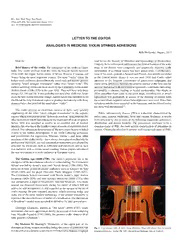
ANALOGIES IN MEDICINE: VIOLIN STRINGS ADHESIONS. PDF
Preview ANALOGIES IN MEDICINE: VIOLIN STRINGS ADHESIONS.
Rev. Inst. Med. Trop. Sao Paulo 55(6):435-436, November-December, 2013 doi: 10.1590/S0036-46652013000600014 LETTER TO THE EDITOR ANALOGIES IN MEDICINE: VIOLIN STRINGS ADHESIONS Belo Horizonte, August, 2013 Dear Sir read before the Society of Obstetrics and Gynecology of Montevideo, Uruguay. In his subsequent publications the clinical features of the acute Brief history of the violin. The emergence of the violin in Upper stage of the disease were completely and graphically depicted. Little Italy: The violin evolved from the viola da braccio family between information of a clinical nature has been added since. Unfortunately, 1520-1550, the Upper Italian towns of Milan, Brescia, Cremona and none of his work, printed in Spanish and French, was widely circulated Venice being the most important centers. The term “violin” (from the in the United States. Hence it was not until 1930 that Curtis called Italian word violino) is derived from the word viola and had the general attention to the frequent coexistence of gonococcic salpingitis and meaning “small stringed instrument” rather than “small viola”. The violin string adhesions between the anterior surface of the liver and the earliest surviving violins are those made by the Cremonese violin maker anterior abdominal wall discovered at operation – conditions indicating, Andrea Amati (1500-1576) in the year 1542. They still have only three presumably, a chronic, healing or healed perihepatitis. Fitz-Hugh, in strings: G3, D4 and A4. It was probably not until after 1550 that Amati 1934, described three cases in the acute stage, including one in which made the first violins with four strings. Andrea Amati was therefore in all laparotomy was performed; in smears of the draining secretions from likelihood the first instrument maker to produce instruments with those the wound Gram-negative intracellular diplococci were seen. Since then characteristics that justified the appellation “violin”. numerous articles have appeared in the literature, and the clinical entity has been well documented”3. The violin proved an enormous success in Italy, very quickly supplanting all the other “small stringed instruments” in the soprano Pelvic inflammatory disease (PID) is a disorder characterized by register which were played in the "da braccio position" (arm position). No pelvic pain, adnexal tenderness, fever and vaginal discharge; it results other instrument which had undergone the major part of its development from infection by one or more of the following organisms: gonococci, before 1650 was accepted so readily as an essential part of musical chlamydiae, and enteric bacteria. The gonococcus continues to be a practice; this was due to the limitless range of means of expression that it common cause of PID, the most serious complication of gonorrhea in offered. The subsequent development of Western music history is linked women. Chlamydia infection is another well-recognized cause of PID2. closely to the further development of the violin’s playing techniques and possibilities for expression. Whereas violins – and later, other members of the violin family – have always been played exclusively by professional musicians, the viol remained an instrument also adopted by educated lay musicians such as noblemen and merchants and as such was endowed with a certain social standing. Italian players introduced the new instrument to a wider audience at European courts. The Golden Age (1600-1750): The violin’s popularity led to the emergence of the most famous schools of violin-making: The Cremonese School was led by Amati’s sons until Nicola Amati (1596-1684). The Brescian School produced master craftsmen such as Gasparo da Salò (1540-1609) and his pupil Giovanni Paolo Maggini (1580-1632). The Cremonese School continued with Nicola Amati’s pupil Andrea Guarnieri (1626-1698) and later Antonio Stradivari (1644-1737), who was presumably a pupil of Guarnieri’s. Antonio Stradivari, who made around one thousand instruments during his career of which 600 are said to be still in existence, is still regarded as the apogee of the art of violin-making. Despite repeated attempts, which continue today and make use of the most modern technology, it has proved impossible to reproduce the sheer brilliance of timbre of a Stradivarius. The dimensions of Stradivari’s model were accepted as definitive by later generations. Giuseppe Guarnieri, known as “del Gesù” (1698-1744), made instruments that were appreciated chiefly on account of their sustaining tone. Niccolò Paganini (1782-1840), the greatest violin virtuoso of all time, played a Guarnieri 1. Dr. Malcom M. Stanley3: “Peritonitis of the upper part of the abdomen in young women occurring during the course of gonorrhea was Fig. 1 - Laparoscopic view of violin string adhesions. Diagnostic picture tests in sexually first described as a definite syndrome in 1919 by Carlos Stajano, in a paper transmitted diseases - Taylor, PK, 1995. Bristol Royal Infirmary, Bristol, England. ANDRADE-FILHO, J.S. - Analogies in Medicine: violin strings adhesions. Rev. Inst. Med. Trop. Sao Paulo, 55(6): 435-6, 2013. In about one half of infected women, gonorrhea remains REFERENCES asymptomatic. The other infected women initially exhibit endocervicitis, with a vaginal discharge or bleeding. Infection often extends to the 1. History of the violin. In: Vienna Symphonic Library. Available from: <http://www. fallopian tubes, where it produces acute and chronicle salpingitis and vsl.co.at/en/70/3189/3190/5620.vsl#top> eventually PID. 2. Kumar V, Abbas AK, Fausto N. Robbins & Cotran pathologic basis of disease. 7th ed. Philadelphia: Elsevier Saunders; 2005. p. 1064-5. From the fallopian tubes, gonorrhea spreads to the peritoneum, healing as fine “violin string” adhesions between the liver capsule and 3. Stanley MM. Gonococci peritonitis of the upper part of the abdomen in young the parietal peritoneum (Stajano - Fitz-Hugh - Curtis syndrome) (Fig. 1). women: phrenic reaction, or subcostal syndrome of Stajano; Fitz-Hugh - Curtis syndrome. Report of cases of three patients treated successfully with penicillin and a summary of the literature. Arch Intern Med (Chic). 1946;78:1-3. doi:10.1001/ José de Souza ANDRADE-FILHO archinte.1946.00220010011001 Faculdade de Ciências Médicas de Minas Gerais Belo Horizonte, Minas Gerais, Brasil E-mail: [email protected] 436
